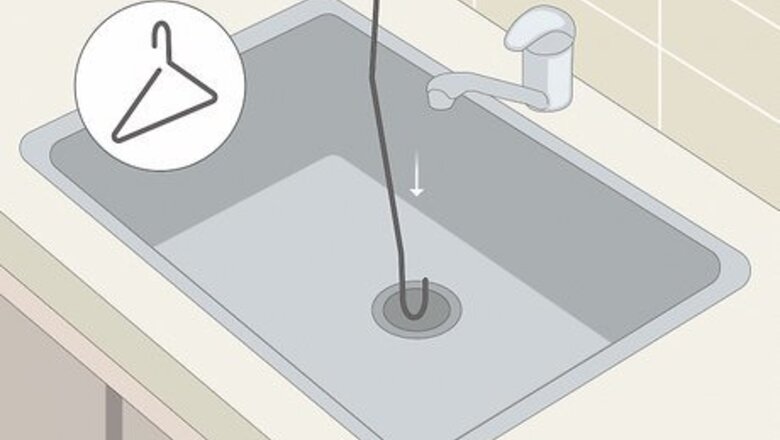
views
- Plunge the sink to loosen the clog. Simply place a plunger over the drain, fill the sink with water, then plunge up and down 20 times.
- Use a wet-dry vacuum to loosen the clog. Hold the vacuum nozzle up against the drain, then turn the vacuum on for 10 seconds.
- Unscrew the P-trap and use a wire brush to clean it out for large clogs.
Manual Removal
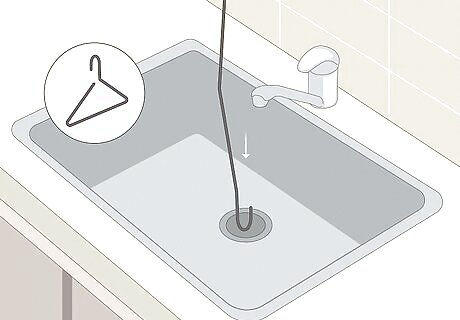
Clear out the blockage with a bent wire hanger. Straighten out a wire clothes hanger as much as possible. Bend one end slightly to create a small hook that fits inside your sink drain. Slide the wire hanger down, hook-side first, into the drain. Once you feel resistance, twist and maneuver the hanger to try and hook the blockage. Pull the wire back up to remove as much of the blockage as possible. Try to keep the wire pressed to the side of the drain rather than pushing it down the center of the pipe. Doing so will minimize the risk of pushing the blockage further down. Run hot tap water from your sink and into the drain for a couple of minutes. Make the water as hot and rapid as possible, but if the sink starts to back up, turn the water off.
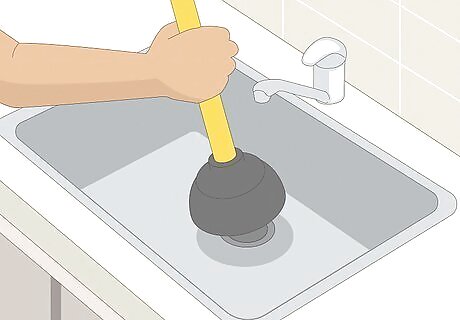
Use a plunger to loosen the clog. If you are working with a sink that has two sink drains, hold a wet cloth tightly over one drain to seal it off. Place a sink plunger over the other drain, holding it fairly upright. Fill the sink with 3 to 4 inches (7.5 to 10 cm) of water. Roll the head of the plunger into the water, forcing water into the drain. Pump the plunger up and down for a solid 20 seconds using a vigorous, rapid motion, but do not break the seal between the plunger and the drain. Pop the plunger off the drain on your last vertical upstroke. You may need to plunge the sink for several minutes in order to loosen the blockage. If you’ve already used drain cleaner or another chemical, don’t plunge your sink. The drain cleaner could splash back up and onto your skin.
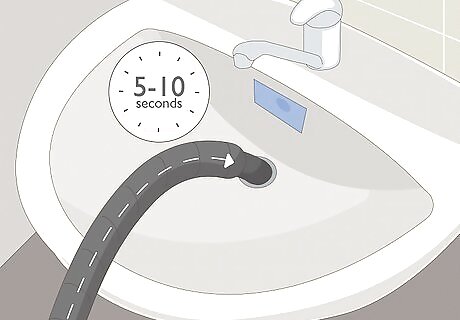
Use a wet-dry vac to dislodge the clog. Wipe down the sink so it’s fully dry, then duct tape the second drain or overflow valve in the sink. Attach the vacuum hose to the back, or blower end, of the vacuum. Press the nozzle onto the drain, creating a seal, then turn the vacuum on. Hold it on the drain for 5 to 10 seconds, then check to see if your drain is still clogged. It’s important to duct tape the overflow valve so the vacuum can create an airtight seal. If you’re working on a sink without an overflow valve or second drain (like a utility sink), then don’t worry about this step. Before you turn the vacuum on, duck down below the sink. Turning the vacuum on might create splashback, which isn’t dangerous—just gross.
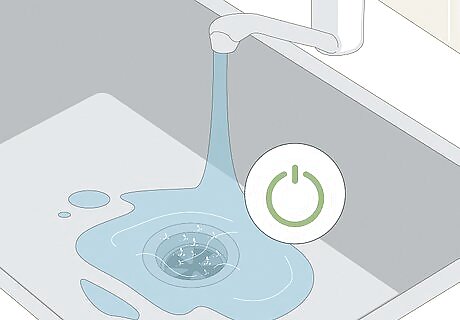
Run the garbage disposal if you have one. Sometimes, a clogged kitchen sink is the result of food getting stuck in the garbage disposal. Run some water and turn on the unit to see if it dislodges any old food. If the disposal doesn’t turn on, the circuit might have tripped due to the blockage. Press the red button on the disposal under the sink to reset the breaker, then try again. If there is something jammed in the disposal (like a bone), unplug the disposal and shine a light into it from the sink. Then, use tongs to dislodge the clog and remove it.
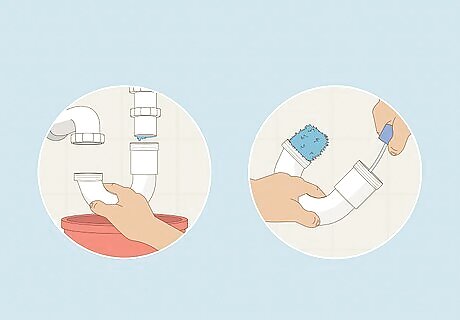
Clean the P-trap to dislodge large clogs. Place a large bucket below the trap underneath your sink. Use slip joint pliers to loosen the slip nuts on the trap and unscrew the nuts by hand. Slide the nuts away from the connections and carefully slip off the trap. Use a small wire brush to scrap out any debris from the trap, emptying it into the bucket below. Then, rinse the trap with hot water. The P-trap often catches debris and other blockages before they make it further into your pipes.This portion of your piping is located directly under your sink and can be removed and cleaned out manually. Reattach the trap to the rest of the piping once it’s clean. If any slip nut washers show notable signs of wear or rust, replace them.
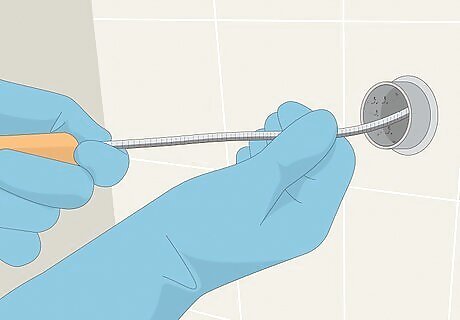
Snake the line to remove deep blockages. If the blockage lies deeper in the sink line, you may need to use a snake to clean it out. Remove the P-trap and any pipes that connect to the drain stub-out at the wall. Pull out 6 to 10 inches (15 to 25 cm) of snake cable. Thread the tip of the snake into the drain stub-out and tighten the setscrew. Turn the crank clockwise to feed it into the pipe. Any initial resistance you feel is likely caused by turns and corners the snake must make. Once you hit a blockage, continue cranking until you feel the tip of the snake cable break through to the other side. The tension in the cable will be reduced dramatically after it breaks through. Turn the crank counter-clockwise to pull the cable out. Clean the cable as you remove it. Repeat as needed until you no longer feel any blockage and restore your piping to its usual state.
Natural Solutions
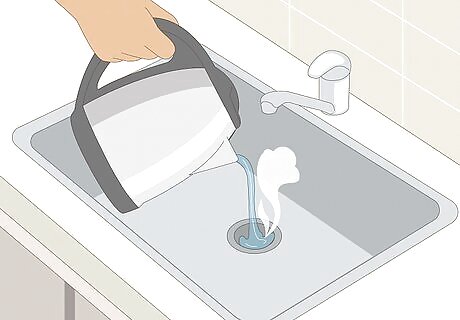
Flush the sink with boiling water. Boil at least 4 cups (1 L) of water in a kettle. After the water boils, pour it down the drain in 2 to 3 stages, pausing for several seconds in between each stage. If the sink is still clogged, try more boiling water. If possible, flush the sink out with at least 4 cups (1 L) of water. Use more if your kettle will hold it. Pour the boiling water directly down the drain, rather than pouring it into the sink first and letting it gradually flow to the drain. This works best on minor clogs, but it might not work as well for a very clogged drain.

Dissolve the clog with baking soda and vinegar. Pour 1/2 cup (125 ml) of baking soda down the sink drain. Follow the baking soda with 1/2 cup (125 ml) of white distilled vinegar. Quickly cover the drain opening with a drain stopper. As soon as the fizzing stops, pour another 1/2 cup (125 ml) of white distilled vinegar down the drain. Cover the drain again and let it sit for 15 to 30 minutes. Boil 1 gallon (4 L) of water in a kettle or saucepan. After 15 to 30 minutes, pour the boiling water into the sink to flush out any remaining vinegar and baking soda.

Pour salt and baking soda into the drain. Combine 1/2 cup (125 ml) of table salt and 1/2 cup (125 ml) of baking soda. Carefully pour or spoon the combination down the sink drain. Let the baking soda and salt sit for 10 to 20 minutes. Then, pour 1 to 4 quarts (1 to 4 L) of boiling water down the drain. Plug up the sink drain as quickly as possible after adding the water to force the reaction down into the pipes rather than up and out. The chemical reaction produced will be enough to clear most moderately clogged sinks.
Heavy-Duty Chemical Help
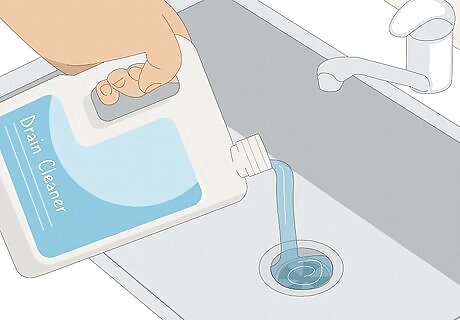
Use a drain cleaner for stubborn clogs. Read the label carefully to determine which cleaner is right for your particular type of blockage. For instance, some cleaners might work better in bathroom sinks, while others might work better for kitchen sinks. Pour the drain cleaner down the drain according to the instructions, then let it sit for 30 minutes to 1 hour. Flush the drain with water to get rid of the clog. Caustic drain cleaners rely on chemical reactions caused by hydroxide ions. Acid drain cleaners use a chemical reaction between hydrogen ions and the material clogging the sink. Acid cleaners tend to be harsher than caustic drain cleaners. Enzymatic cleaners are the least potent and rely on bacterial enzymes to eat away organic blockages. Do not use a drain cleaner if you have already used bleach or other chemical solutions. Drain cleaners cannot be mixed with other chemicals, since the combinations can create dangerous gasses.
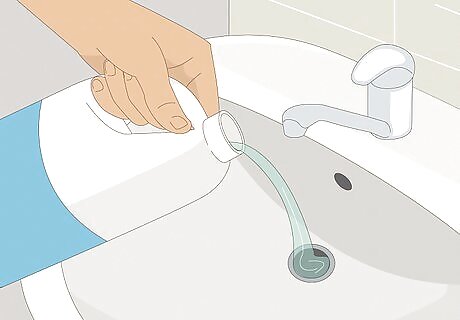
Pour bleach down the sink to dissolve clogs. Pour 1 cup (250 ml) of undiluted bleach directly down the sink drain. Let it sit for 5 to 10 minutes, then turn on your sink and let water run into the drain for 5 minutes. If your sink begins to back up and fill with water, turn the water off and let it drain before attempting to unclog the sink again. Do not use bleach if you use a septic tank. Bleach kills bacteria living in the tank, but the bacteria it kills eats solid waste, thereby preventing the lines from clogging. Do not use bleach if you have already used a drain cleaner or other chemicals. Bleach cannot be mixed with ammonia, or it creates a dangerous gas.
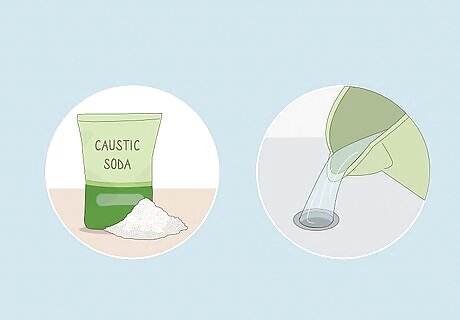
Pour caustic soda down the drain. Dilute 3 cups (750 ml) of caustic soda with 3/4 gallon (3 L) of cold water in a large mop bucket. Mix the chemical and the water together with a wooden spoon. Carefully pour the solution directly into the clogged sink drain. Let sit for 20 to 30 minutes without touching it. Then, flush the drain with 1 gallon (4 L) of boiling water. Do not use any container or utensil you plan to use for food later on. Do not stir the water and caustic soda together with your hands, since it can cause skin irritation. The water and caustic soda will begin to "fizz" and heat up as you mix the two together. Add the caustic soda to the water, never the other way around! If water is added to caustic soda, an exothermic reaction will cause the solution to possibly boil and splash on you, causing serious chemical and thermal burns.


















Comments
0 comment